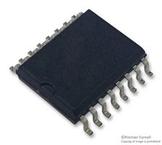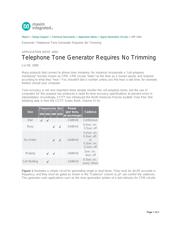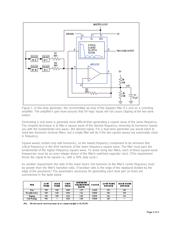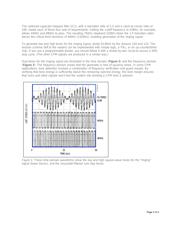herunterladen

Maxim > Design Support > Technical Documents > Application Notes > Signal Generation Circuits > APP 1904
Keywords: Telephone Tone Generator Requires No Trimming
APPLICATION NOTE 1904
Telephone Tone Generator Requires No Trimming
Jul 09, 1998
Many products that connect to phone lines (modems, for instance) incorporate a "call-progress
monitoring" function known as CPM. CPM circuits "listen" to the lines as a human would, and respond
according to what they "hear." You shouldn't dial a number unless you first hear a dial tone, for example.
Neither should your computer.
Tone accuracy is not very important when people monitor the call-progress tones, but the use of
computers for this purpose has produced a need for tone-accuracy specifications to prevent errors in
interpretation. Accordingly, CCITT has introduced the North American Precise Audible Tone Plan (the
following data is from the CCITT Green Book, Volume VI-4):
Use
Frequencies (Hz) Power
(per tone,
at exchange)
Cadence
350 440 480 620
Dial
-13dBm0 Continuous
Busy
-24dBm0
0.5sec on;
0.5sec off
Re-Order
-24dBm0
0.2sec on;
0.3sec off;
or
0.3sec on;
0.2sec off
Ringing
-19dBm0
2sec on;
4sec off
Call Waiting
-13dBm0
0.3sec on;
every 10sec
Figure 1 illustrates a simple circuit for generating single or dual tones. They must be ±0.5% accurate in
frequency, and they must be gated as shown in the "Cadence" column (a µP can control the cadence).
This generator suits applications such as the tone-generation portion of a test stimulus for CPM circuits.
Page 1 of 4






